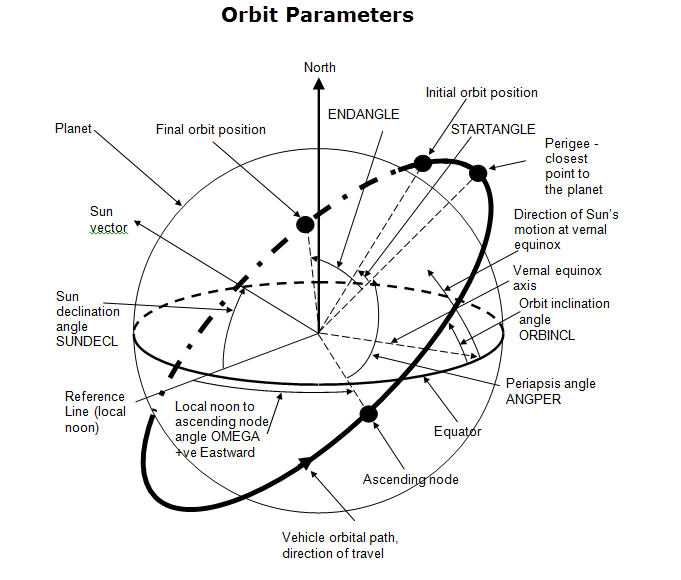Card 6l - Additional Orbital Parameters ORBADD
This optional card set additional orbital parameters.
Parameters: L, STARTANGLE, ENDANGLE,
TIMEI, ANGX, ANGY,
ANGZ, ORDER, DANGX,
DANGY, DANGZ, OMEGASTAR,
PHISTAR, THETASTAR
This card must follow a Card 6k Orbit Definition Card. If absent, all its parameters default to 0. ENDANGLE defaults to 360 degrees.
L
L is the code ORBADD (or 23).
STARTANGLE
STARTANGLE is the initial orbit position in degrees.
STARTANGLE is measured in the orbit plane, starting from the
periapsis, and is positive in the direction of the motion of the spacecraft.
For ORIENT=SURFACE, STARTANGLE is the number of degrees the planet
has rotated from local midnight for the start of the orbit. For a 6:00 AM start
STARTANGLE should be 90 degrees.
ENDANGLE
ENDANGLE is the final orbit position in degrees.
ENDANGLE is measured in the orbit plane, starting from the
periapsis, and is positive in the direction of the motion of the spacecraft.
For ORIENT=SURFACE, ENDANGLE is the number of degrees the planet has
rotated from local midnight for the end of the orbit. For a 5:00 PM end ENDANGLE
should be 255 degrees.
TIMEI
TIMEI is the TIME parameter value at STARTANGLE.
If ENDANGLE–STARTANGLE = 360, TIMEI must be 0, i.e. a full orbit must start at TIMEI = 0.
ANGX, ANGY, ANGZ
ANGX, ANGY, ANGZ are the angles in
degrees which define the orientation of the vehicle coordinate system (as defined by
the ORIENT on Card 6k) at TIME = TIMEI with respect to the global (model’s)
coordinate system.
If the two coordinate systems coincide and are stationary relative to each other, i.e. DANGX, DANGY, DANGZ are blank, then ANGX, ANGY, ANGZ, and ORDER must also be blank.
ORDER
ORDER determines the order of the rotations by which the vehicle
coordinate system is rotated into the global (model's) coordinate system. ORDER may
be the codes: XYZ, XZY, YXZ, YZX, ZXY, or ZYX (or 1 to 6), defining the axes of
rotation in the order the rotations are performed.
For example, if ORDER is XZY, to arrive at the global coordinate system you must first rotate counterclockwise about the vehicle coordinate system's X axis by ANGX, then next about the new Z axis by ANGZ, then about the new Y axis by ANGY.
DANGX, DANGY, DANGZ
DANGX, DANGY, DANGZ are the
rotational angle increments in degrees for ANGX,
ANGY, ANGZ after one complete orbit.
If these are blank or zero, the vehicle coordinate system is fixed with respect to the global coordinate system. For example, the rotation AX(t) about the X axis at TIME = t is computed with:
OMEGASTAR
OMEGASTAR is the angle of the vernal equinox in degrees from the
Reference Line. The vernal equinox is a vector along the line of intersection of the
ecliptic and equatorial planes, pointing in the direction where the sun crosses the
equator going Northwards.
PHISTAR
PHISTAR is the angle between the projection of the star vector on
the equatorial plane and the angle of the vernal equinox measured counter clockwise
when looking southwards.
THETASTAR
THETASTAR is the angle between the vector pointing towards the star
and the North vector.
Code example
In this example, the spacecraft is in geosynchronous (SMAR = 6.625, PERIOD = 24) equatorial (ORBINCL = 0) orbit, during equinox (SUNDECL = 0). Solar eclipse calculations with shadowing (L = ORBSALL), are performed every 2 hours (NINT = 12), plus just before and just after entering and exiting eclipse. No Earth view factor or albedo factor calculations are performed (ALB = 0). The vehicle coordinate system's X axis points towards the Earth, its Z axis North, and its Y axis West (ORIENT = PLANET). The spacecraft's Z axis points away from the Earth, its Y axis is positive in the direction of the motion (towards East), and its X axis points southward. To get to the model's coordinate system, the vehicle coordinate system is rotated 180 degrees counterclockwise about its Z axis, then 90 degrees counterclockwise about its new Y axis.
ORBSALL PLANET 0 12 0 0 0 6.625 180 0 24.0 $ CARD 6K EXAMPLE
ORBADD 0 360 0 0 90 180 ZYX $ S/C ORIENTATION IN ORBIT
